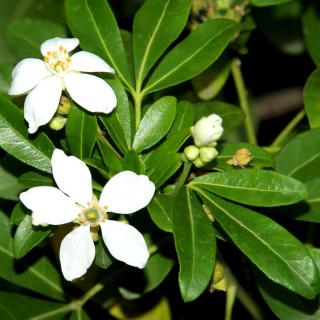

The Mexican orange tree is a marvel at the beginning of spring with its magnificent little white flowers that smother the entire shrub.
Main Mexican Orange facts
Name – Choisya ternata
Family – Rutaceae (Rue family)
Type – shrub
Use – hedge, standalone, garden box and flower bed
Height – 6 to 10 feet (2 to 3 meters)
Exposure – full sun – Foliage – evergreen – Flowering – Spring
Planting, pruning and caring for it are steps you can perform to enhance blooming and growth of this exceptional shrub.
 It is best to plant Mexican orange tree in spring or in fall.
It is best to plant Mexican orange tree in spring or in fall.
If purchased in a pot or in a container, planting is also possible anytime during the year while avoiding frost spells and high temperatures.
Right from the start, water abundantly and regularly, albeit without flooding the roots of the shrub.
The best technique to multiply Mexican orange tree is cuttings. This method is both simple and easy to perform.
You can prepare Mexican orange tree cuttings best in summer, on wood that is not bearing flowers.
 What you’ve got here is a an evergreen shrub that only requires little care, but for which a little attention will increase growing and blooming.
What you’ve got here is a an evergreen shrub that only requires little care, but for which a little attention will increase growing and blooming.
If your Mexican orange tree flowers only a little or not at all, or that leaves stay abnormally small, your soil is probably lacking some type of nutrient.
A Mexican orange tree, whether standalone, part of a hedge or in a flower bed doesn’t require any particular pruning.
But it is often nicer to succeed in giving it a nice shape, especially when it is part of a hedge.
 A very elegant shrub with a dense shape and magnificent blooming, the Mexican orange tree, as its name shows, is native to that North American country.
A very elegant shrub with a dense shape and magnificent blooming, the Mexican orange tree, as its name shows, is native to that North American country.
Varieties such as ‘Aztec Pearl’ or ‘Sundance’ and others make for very easy growing and Mexican orange has the advantage of never growing taller than 6 to 10 feet (2 to 3 meters) tall, which means regular pruning isn’t necessary.
Even if you let the shrub grow without ever pruning it, it will never grow higher than 10 feet (3 meters) high.
The flowers, similar to those of an orange tree, are very fragrant and this shrub adapts very well to direct growing and to growing in pots on a terrace or balcony.
Read more about shrubs and their use in the garden:
Apart from the planting and the subsequent first year, there is no need to water excessively because the Mexican orange tree doesn’t need it.